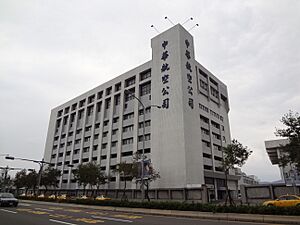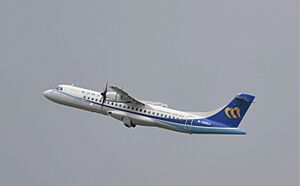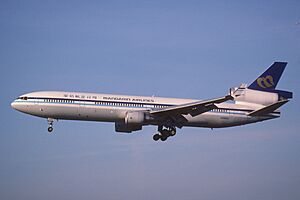Mandarin Airlines facts for kids
Mandarin Airlines ATR 72-600 landing
|
|
| Founded | 1 June 1991 |
|---|---|
| Commenced operations | 16 October 1991 |
| Hubs | Taipei–Songshan |
| Focus cities |
|
| Frequent-flyer program | Dynasty Flyer |
| Alliance | SkyTeam (affiliate) |
| Fleet size | 12 |
| Destinations | 34 |
| Parent company | China Airlines Group |
| Headquarters | Songshan, Taipei, Taiwan |
| Key people | Kao Shing Hwang (Chairman) |
Mandarin Airlines (traditional Chinese: 華信航空; simplified Chinese: 华信航空; pinyin: Huáxìn Hángkōng) is an airline from Taiwan. It is based in Taipei and is part of the China Airlines Group. Mandarin Airlines flies to places within Taiwan and to nearby countries. Its parent company, China Airlines, mostly handles longer international flights.
Mandarin Airlines also offers some special charter flights. Its main bases are Songshan Airport in Taipei, Taichung International Airport, and Kaohsiung International Airport.
Contents
History of Mandarin Airlines
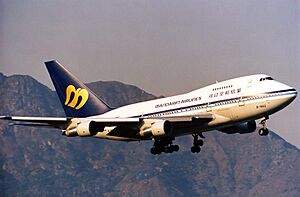
How Mandarin Airlines Started
Mandarin Airlines began on June 1, 1991. It was a partnership between China Airlines and the Koos Group. The name "Mandarin" comes from combining parts of their original Chinese names.
The airline was created because of a special situation for Taiwan. At that time, China Airlines used the flag of the Republic of China on its planes. Some countries, like the People's Republic of China, did not like this. They tried to stop China Airlines from flying to certain places.
However, these objections did not apply to other Taiwanese airlines that did not show the flag. So, Mandarin Airlines was founded as a way to fly to more international destinations without these problems.
Early Flights and Changes
On October 16, 1991, Mandarin Airlines started flying. Its first direct flight was from Taipei to Sydney, Australia. Then, on December 7, 1991, it opened a direct route to Vancouver, Canada. This made Mandarin Airlines the first Taiwanese airline to fly directly to Australia and Canada.
In October 1992, the Koos Group left the partnership. This made China Airlines almost the full owner of Mandarin Airlines. Mandarin Airlines then changed its focus. It became an airline mainly for domestic flights within Taiwan and short flights to nearby regions. This happened because China Airlines changed its plane designs to not include the national flag, which helped it fly more international routes without issues.
Merger and Fleet Changes
On August 8, 1999, Mandarin Airlines combined with another airline called Formosa Airlines. Mandarin Airlines took over Formosa's flights within Taiwan and its planes. In return, most of Mandarin Airlines' international flights and larger planes went to China Airlines.
In the early 2000s, Mandarin Airlines bought five Dornier 228 planes. These were used for routes to smaller, less busy places. These planes were later sold in 2005.
As of March 2007, China Airlines owns most of Mandarin Airlines (93.99%). Mandarin Airlines has about 630 employees.
About Mandarin Airlines
Where is the Main Office?
The main office of Mandarin Airlines is in the Songshan District of Taipei, Taiwan. It used to be in a different building in Taipei.
What is the Logo?
The airline's logo is a Hai Tung Ching (traditional Chinese: 海東青; simplified Chinese: 海东青; pinyin: Hǎidōngqīng). This is a type of gyrfalcon from an old Chinese story. It represents strength and speed.
Where Mandarin Airlines Flies
As of June 2024, Mandarin Airlines flies to many places. Some of these flights are special charter services or include stops in other countries.
| Country | City | Airport | Notes | Refs |
|---|---|---|---|---|
| Australia | Brisbane | Brisbane Airport | Terminated | |
| Sydney | Sydney Airport | Terminated | ||
| Canada | Vancouver | Vancouver International Airport | Terminated | |
| China | Changchun | Changchun Longjia International Airport | Terminated | |
| Changsha | Changsha Huanghua International Airport | Terminated | ||
| Fuzhou | Fuzhou Changle International Airport | |||
| Hangzhou | Hangzhou Xiaoshan International Airport | Terminated | ||
| Jieyang | Jieyang Chaoshan International Airport | Terminated | ||
| Lijiang | Lijiang Sanyi International Airport | Terminated | ||
| Nanjing | Nanjing Lukou International Airport | Terminated | ||
| Ningbo | Ningbo Lishe International Airport | Terminated | ||
| Shenyang | Shenyang Taoxian International Airport | |||
| Wenzhou | Wenzhou Longwan International Airport | |||
| Wuhan | Wuhan Tianhe International Airport | |||
| Wuxi | Sunan Shuofang International Airport | Terminated | ||
| Xiamen | Xiamen Gaoqi International Airport | |||
| Yancheng | Yancheng Nanyang International Airport | Terminated | ||
| Zhengzhou | Zhengzhou Xinzheng International Airport | Terminated | ||
| Germany | Frankfurt | Frankfurt Airport | Terminated | |
| Hong Kong | Hong Kong | Hong Kong International Airport | Terminated | |
| Kai Tak Airport | Airport closed | |||
| Japan | Ishigaki | New Ishigaki Airport | Terminated | |
| Ōita | Oita Airport Charter | Terminated | ||
| Osaka | Kansai International Airport | Terminated | ||
| Tokyo | Narita International Airport | Terminated | ||
| Macau | Macau | Macau International Airport | Terminated | |
| Netherlands | Amsterdam | Amsterdam Airport Schiphol | Terminated | |
| Philippines | Cebu | Mactan–Cebu International Airport | Terminated | |
| Kalibo | Kalibo International Airport | Terminated | ||
| Laoag | Laoag International Airport | Terminated | ||
| South Korea | Seoul | Incheon International Airport | Terminated | |
| Taiwan | Hualien | Hualien Airport | ||
| Kaohsiung | Kaohsiung International Airport | Focus city | ||
| Kinmen | Kinmen Airport | |||
| Nangan | Nangan Airport | |||
| Penghu | Penghu Airport | |||
| Taichung | Taichung International Airport | Focus city | ||
| Taipei | Songshan Airport | Hub | ||
| Taoyuan International Airport | ||||
| Taitung | Taitung Airport | |||
| Thailand | Bangkok | Don Mueang International Airport | Terminated | |
| Vietnam | Hanoi | Noi Bai International Airport | Terminated | |
| Ho Chi Minh City | Tan Son Nhat International Airport |
Airline Partnerships
Mandarin Airlines works with other airlines to make travel easier.
- Interline agreements: These allow passengers to book flights on different airlines using one ticket. Mandarin Airlines has this with Singapore Airlines.
- Codeshare agreements: These mean two or more airlines share the same flight. You might buy a ticket from one airline, but fly on a plane operated by another. Mandarin Airlines has codeshare agreements with:
* China Airlines * China Eastern Airlines * China Southern Airlines * XiamenAir
Mandarin Airlines Fleet
Current Aircraft
As of May 2025, Mandarin Airlines uses these planes:
| Aircraft | In service |
Orders | Passengers | Notes | ||
|---|---|---|---|---|---|---|
| C | Y | Total | ||||
| ATR 72-600 | 12 | 3 | — | 70 | 70 | New planes are being delivered until 2025. |
| Boeing 737-800 | 1 | — | 8 | 150 | 158 | |
| Total | 12 | 3 | ||||
Changes in Aircraft Over Time
In December 2005, Mandarin Airlines decided to lease eight Embraer E190 planes. These new planes replaced older Fokker 50 and Fokker 100 aircraft. The first Embraer E190 arrived in May 2007. Mandarin Airlines was the first airline in Taiwan to use this type of plane.
On October 27, 2009, Mandarin Airlines stopped using its last Fokker 100 plane. This ended 14 years of service for that type of aircraft with the airline. In July 2017, Mandarin Airlines ordered six ATR 72-600 planes, which started arriving in 2018.
Former Aircraft
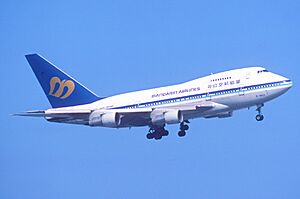
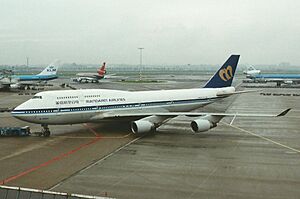
In the past, Mandarin Airlines used these types of planes:
| Aircraft | Total | Introduced | Retired | Notes |
|---|---|---|---|---|
| Airbus A340-300 | 1 | 2006 | 2007 | |
| Boeing 737-800 | 6 | 2000 | 2019 | These planes went back to China Airlines. |
| Boeing 747-400 | 1 | 1995 | 2000 | This plane was moved to China Airlines. |
| Boeing 747SP | 4 | 1991 | 2004 | |
| Dornier 228 | 4 | 2000 | 2005 | |
| Embraer E190 | 8 | 2007 | 2021 | |
| Fokker 50 | 7 | 1999 | 2008 | |
| Fokker 100 | 6 | 1999 | 2009 | |
| McDonnell Douglas MD-11 | 5 | 1993 | 2002 | |
| Saab 340 | 1 | 1999 | 2000 | This plane was moved to Golden Air. |
Incidents and Safety
As of 2024, Mandarin Airlines has been involved in two incidents where no planes were lost and no one was seriously hurt.
There was a crash of a McDonnell Douglas MD-11 plane at Hong Kong International Airport on August 22, 1999. Three people died in this accident. This plane had once worn Mandarin Airlines' colors, but it was being operated by China Airlines at the time of the crash. It had been transferred from Mandarin Airlines three months before the accident.
- On December 6, 2006, Mandarin Airlines Flight 1261 flew from Taipei to Kinmen. After landing, it was found that a wheel from the front landing gear had fallen off. The wheel was later found near the runway at Songshan Airport. Luckily, no one was hurt.
- On August 17, 2012, Mandarin Airlines Flight 369 went off the runway during heavy rain at Magong Airport. This happened because of how the plane landed and slowed down. The pilot purposely steered the E-190 plane off the side of the runway. It hit some concrete lights, and the nose landing gear broke. No injuries were reported in this incident.
See also
 In Spanish: Mandarin Airlines para niños
In Spanish: Mandarin Airlines para niños
- List of airlines of Taiwan
- Air transport in Taiwan
- List of airports in Taiwan
- List of companies of Taiwan
- Transportation in Taiwan
- China Airlines


